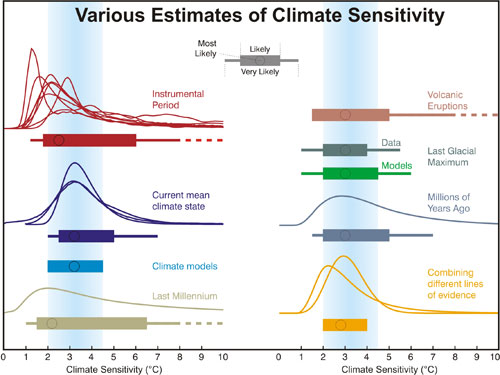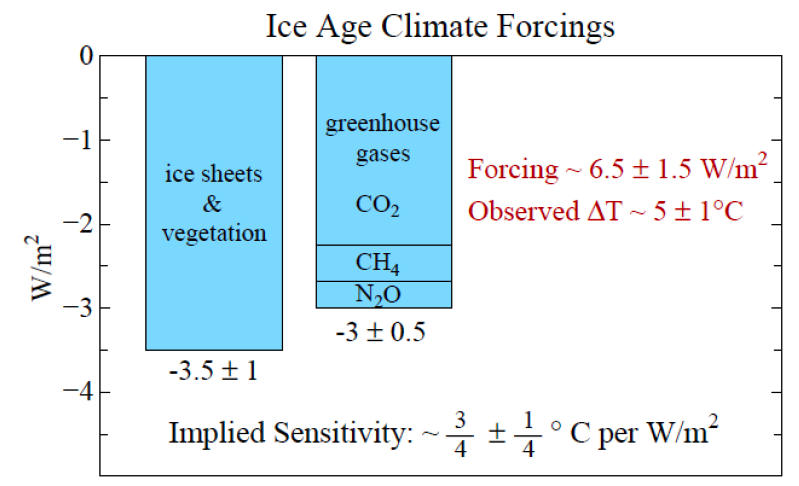Christy Crock #6: Climate Sensitivity
Posted on 7 June 2011 by dana1981, James Wight
 In recent months, climate scientist "skeptic" John Christy seems to have grown an appetite for the limelight. First he testified before U.S. Congress, then he appeared on an Australian radio talk show to discourage their country from implementing a carbon tax, and now he has appeared on a Canadian radio show to downplay the link between global warming and extreme weather. In the process, he made one of the "skeptics" favorite arguments: climate sensitivity is low.
In recent months, climate scientist "skeptic" John Christy seems to have grown an appetite for the limelight. First he testified before U.S. Congress, then he appeared on an Australian radio talk show to discourage their country from implementing a carbon tax, and now he has appeared on a Canadian radio show to downplay the link between global warming and extreme weather. In the process, he made one of the "skeptics" favorite arguments: climate sensitivity is low.
"We are finding that the climate is not very sensitive to CO2 and those kind of gases"
This statement is strikingly similar to one which we examined in Lindzen Illusion #4:
"If we doubled CO2, it's well accepted that you should get about 1 degree warming if nothing else happened....is what we've seen so far suggesting that you have more than that, and the answer is no."
We've also addressed the "low sensitivity" claims of Roy Spencer, David Evans, and Christopher Monckton. It's not surprising that this is a favored "skeptic" argument, because low sensitivity is absolutely critical to arguing that global warming is of no concern, and opposing carbon emissions reductions. I've previously even gone so far as to describe it as the "skeptic" endgame.
Christy and Lindzen's similar quotes are particularly puzzling because of their use of the term "we". When I hear a climate scientist use the phrase "what we've seen" or "we are finding" when discussing a climate research issue like sensitivity, I assume they are referring to the body of climate science research. But as we have discussed ad nauseam, the body of climate science research is in very strong agreement that climate sensitivity is not low, but rather likely between 2 and 4.5°C for doubled atmospheric CO2 (Figure 1). In fact there are very few exceptions to this strong agreement, which are generally limited to fundamentally flawed papers by these same few "skeptics", like Lindzen and Choi (2009) or Roy Spencer's blunders and 'silver bullets'.

It becomes a bit frustrating that these few "skeptics" continue to claim with such certainty that sensitivity is low, and in such a misleading fashion (i.e. saying "we" rather than "the work of a few like Lindzen and Spencer"), even though we have debunked this myth many times before. But Christy's repetition of the myth does give us the opportunity to discuss an interesting recent draft paper which examined the issue of climate sensitivity: Hansen and Sato's Paleoclimate Implications for Human-Made Climate Change.
Hansen and Sato (2011)
In the paper, Hansen and Sato evaluate fast-feedback climate sensitivity based on the radiative forcings in the last ice age (~20,000 years ago) compared to those during the Holocene prior to the Industrial Revolution (Figure 2), knowing that the planet was near equilibrium during these two periods:
"Climate, averaged over a few millennia, must be in near-equilibrium during the last ice age (~20 ky ago) and in the current interglacial period prior to introduction of substantial human-made climate forcings. Any planetary energy imbalance was at most a small fraction of 1 W/m2, as shown by considering the contrary: an imbalance approaching 1 W/m2 would be sufficient to melt all ice on Earth or change ocean temperature a large amount, contrary to numerous paleoclimate data records."

Figure 2: Climate forcings during the ice age 20 ky ago relative to the pre-industrial Holocene from Hansen and Sato (2011)
As you can see in Figure 1, the radiative forcing in the last ice age as compared to the pre-industrial Holocene is -6.5 +/- 1.5 W/m2. The average global temperature was 5 +/- 1°C cooler during the past ice age, which means the climate sensitivity is 5°C/6.5 W/m2, or approximately 0.77°C per W/m2. Since the radiative forcing associated with doubled CO2 is 3.7 W/m2, this implies a fast-feedback climate sensitivity of 2.8°C. Note that this is an empirical result based on real-world observations of climate change in the relatively recent past.
Hansen and Sato break down the approximate contributions of CO2 and feedbacks to this doubled CO2 warming:
"If Earth were a blackbody without climate feedbacks the equilibrium response to 4 W/m2 forcing would be about 1.2°C (Hansen et al., 1981, 1984). The water vapor increase and sea ice decrease that accompany global warming can be simulated reasonably well by climate models; together these two feedbacks approximately double the blackbody sensitivity. The further amplification is the net effect of all other processes, with aerosols, clouds, and their interactions probably being the most important of the remaining feedback processes."
The paper goes on to note that during the Pliocene, which was only 1-2°C hotter than current global temperatures, and also the last time CO2 levels were as high as today, average sea level was 25 meters higher (a subject which John Cook recently discussed).
In another of Hansen’s draft papers, Earth’s Energy Imbalance and Implications, he concludes that slow feedbacks greatly amplify the 3°C sensitivity from fast feedbacks. The exact value depends on the climate state you start with, which feedbacks you include, what timescale you’re interested in, and what assumptions you make. Adding other greenhouse gases increases climate sensitivity to 4°C for doubled CO2, and adding ice albedo gives 8°C for doubled CO2 (as long as the Earth has ice sheets). These feedbacks have historically occurred over centuries to millennia, but could become significant this century. Including CO2 itself as a feedback would make climate sensitivity even higher, except for the weathering feedback which operates over hundreds of millennia.
To avoid kicking off slow feedbacks, Hansen advises that we return the Earth to energy balance by eventually reducing atmospheric CO2 levels to 350 ppm. Of course if we listen to the 'low sensitivity' crowd and buy into the wishful thinking that CO2 emissions are of little concern, we will blow post the 2°C danger limit (approximately 450 ppm CO2), let alone giving ourselves a reasonable chance to eventually reduce CO2 levels to 350 ppm.
Self-Contradiction
Astute Skeptical Science readers may have noticed that "climate's changed before" recently supplanted "it's the Sun" as the #1 most used "skeptic" argument. In the same radio interview, Christy made a similar argument, first specifically regarding extreme weather events:
"In looking at the best climate data through the past, these events are not outside the range that of what has already occurred"
But he then expanded the argument further:
"Extremes events are not the key that you look for, you look for a large global number in the heat storage of the atmosphere and ocean and that is rising slowly but it is not rising catastrophically or dramatically and certainly does not point to a high sensitivity of the climate to things like greenhouse gases."
This is simply wrong, because as we saw in Lindzen Illusion #1, the amount of warming we've observed is consistent with a climate sensitivity of approximately 3°C for doubled CO2. With these two statements, Christy seems to be trying to weave several climate myths together to make an argument something like "climate has changed before, the current warming isn't very significant, it points to low climate sensitivity, and it could just be natural variability." This sort of storyline is consistent with Christy's recent claims in the media and before US Congress, and similar to the alternative hypothesis to anthropogenic global warming that Lindzen put together.
The problem, aside from being wrong, is that it's self-contradictory. The climate certainly has changed before, and by large amounts. How can we explain the ~5°C increase in average global surface temperature between glacial and interglacial periods if climate sensitivity is low? Natural variability can only account for fractions of a degree change, and the Milankovitch orbital forcing isn't that large, especially if sensitivity is low.
As Hansen and Sato and many other studies have showed, these past climate changes are consistent with a climate sensitivity of 3°C. The larger the past climate change, the larger sensitivity is required to explain them. So arguing both for low sensitivity and large past climate changes is self-contradictory.
Misleading Christy
In short, Christy and the other "skeptics" who are claiming high certainty that climate sensitivity is low are not only contradicted by dozens of studies on the subject, including Hansen's empirically-based paleoclimate assessments, and by their own claims of large past climate changes, but they are advocating that we continue on an extremely risky path.
It's particularly disturbing when these "skeptics" claim in the media that "we" are seeing evidence that climate sensitivity is low, implying that they are referring to the body of climate science research, when in fact the opposite is true. In doing so they mislead the public about the actual state of the scientific research on climate sensitivity, which may lead people to the mistaken conclusion that urgent action is unnecessary. In fact Christy seems to be going on an international public misinformation tour, having recently made similar misleading statements to the American, Australian, and Canadian public: a disturbing trend.































 Arguments
Arguments






























[dana1981] Thanks very much. The "skeptics" have given us a lot of practice in rebutting "climate sensitivity is low"!
[dana1981] Lucky us?
[DB] You should re-read your comment and think about what perceptions that other readers are apt to draw from it. After reflection, you may wish to issue a revision to this comment.